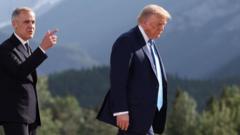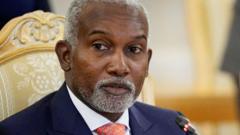In a significant policy shift aimed at enhancing operations, Starbucks has informed its corporate employees that they must work in the office for four days a week, with the option of a one-time payout for those who choose to leave the company instead.
Starbucks Mandates In-Office Work for Employees Four Days a Week

Starbucks Mandates In-Office Work for Employees Four Days a Week
Starbucks announces a new in-office policy, affecting corporate employees from October.
Starbucks has mandated that corporate staff work in-office four days each week starting in October, a change from the previously enforced requirement of three days. This new rule, primarily impacting employees in the U.S. and Canada, marks a trend among corporations tightening remote work after its surge during the COVID-19 pandemic. Employees choosing to opt-out will receive a one-time financial incentive upon departure.
Brian Niccol, the newly appointed CEO, emphasized that the change aims to bolster the company's performance amid declining sales and numerous operational challenges. In a company blog post, Niccol asserted, "We understand not everyone will agree with this approach... But as a company built on human connection… we believe this is the right path for Starbucks."
This policy includes a requirement for certain managerial staff to relocate either to Seattle, where Starbucks is headquartered, or to Toronto, following Niccol's move to establish a residence in Seattle despite his initial contract stipulating the possibility of a remote office near his California home.
These adjustments are part of Niccol's broader strategy to revitalize Starbucks. Other changes entail overhauls to the menu and shop concepts, as well as the retraction of a hospitality policy that permitted non-purchasing customers to utilize cafe facilities freely. Earlier this year, Starbucks also underwent a substantial job reduction, cutting approximately 1,100 roles.
The trend into stricter work policies is not unique to Starbucks; notable companies like Amazon and JP Morgan have also tightened remote work regulations. Research conducted by institutions such as Stanford University and the University of Chicago shows that around one-third of U.S. staff who can work remotely have returned to full-time office work, while 20% remain completely remote, leaving 45% enjoying a hybrid work model.
Starbucks is also making moves to recruit more baristas, committed to rebuilding its customer base in the wake of these operational changes.
Brian Niccol, the newly appointed CEO, emphasized that the change aims to bolster the company's performance amid declining sales and numerous operational challenges. In a company blog post, Niccol asserted, "We understand not everyone will agree with this approach... But as a company built on human connection… we believe this is the right path for Starbucks."
This policy includes a requirement for certain managerial staff to relocate either to Seattle, where Starbucks is headquartered, or to Toronto, following Niccol's move to establish a residence in Seattle despite his initial contract stipulating the possibility of a remote office near his California home.
These adjustments are part of Niccol's broader strategy to revitalize Starbucks. Other changes entail overhauls to the menu and shop concepts, as well as the retraction of a hospitality policy that permitted non-purchasing customers to utilize cafe facilities freely. Earlier this year, Starbucks also underwent a substantial job reduction, cutting approximately 1,100 roles.
The trend into stricter work policies is not unique to Starbucks; notable companies like Amazon and JP Morgan have also tightened remote work regulations. Research conducted by institutions such as Stanford University and the University of Chicago shows that around one-third of U.S. staff who can work remotely have returned to full-time office work, while 20% remain completely remote, leaving 45% enjoying a hybrid work model.
Starbucks is also making moves to recruit more baristas, committed to rebuilding its customer base in the wake of these operational changes.

















